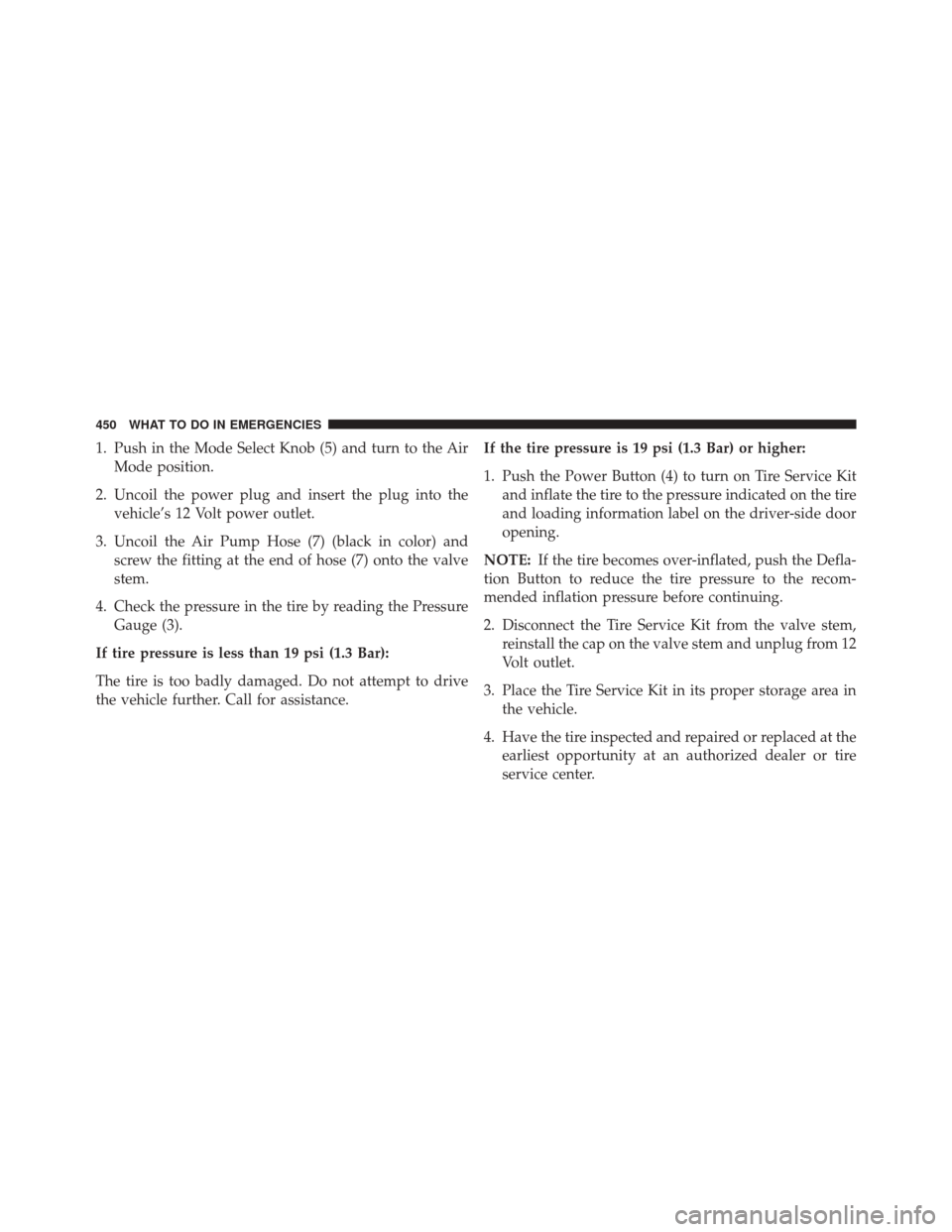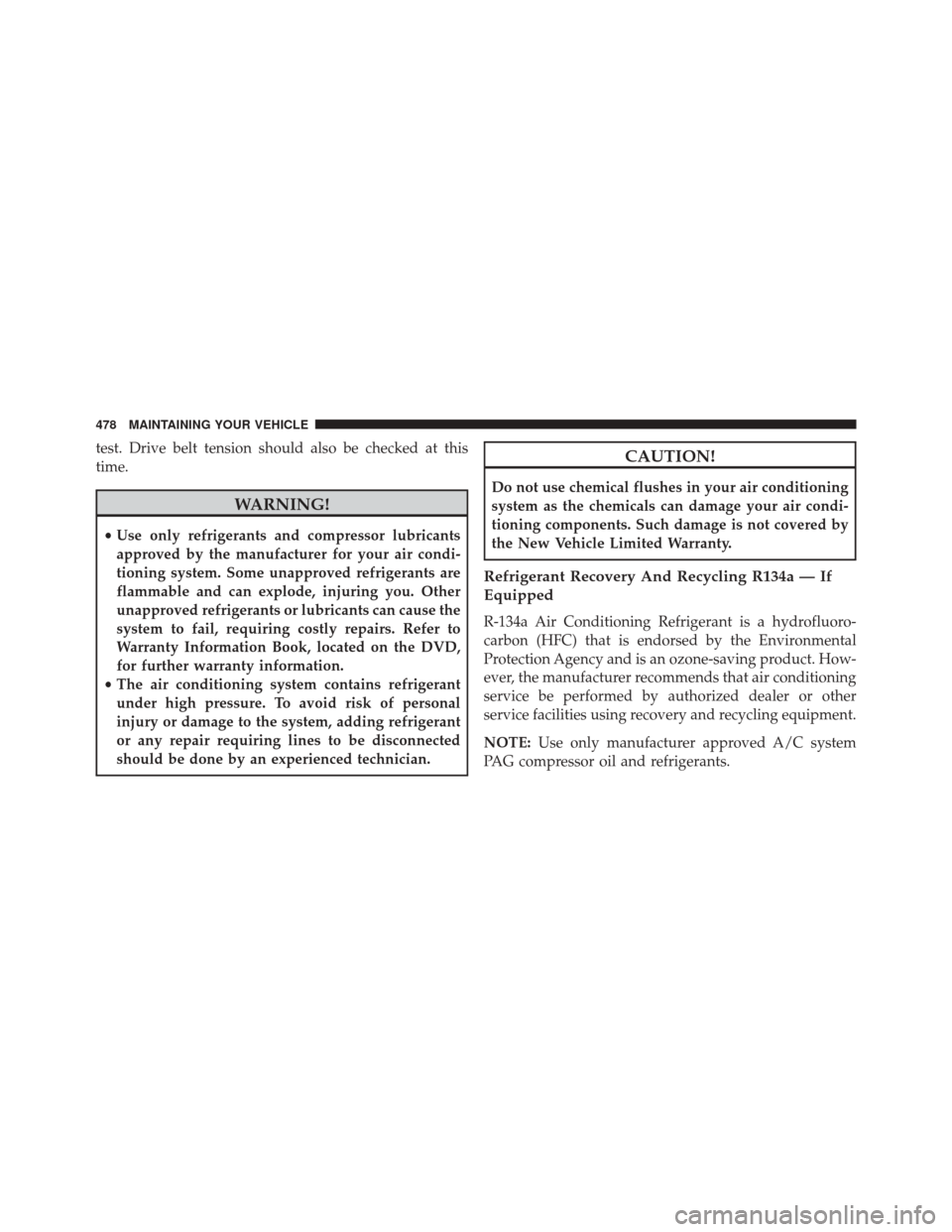2015 DODGE CHALLENGER SRT check oil
[x] Cancel search: check oilPage 452 of 575

1. Push in the Mode Select Knob (5) and turn to the AirMode position.
2. Uncoil the power plug and insert the plug into the vehicle’s 12 Volt power outlet.
3. Uncoil the Air Pump Hose (7) (black in color) and screw the fitting at the end of hose (7) onto the valve
stem.
4. Check the pressure in the tire by reading the Pressure Gauge (3).
If tire pressure is less than 19 psi (1.3 Bar):
The tire is too badly damaged. Do not attempt to drive
the vehicle further. Call for assistance. If the tire pressure is 19 psi (1.3 Bar) or higher:
1. Push the Power Button (4) to turn on Tire Service Kit
and inflate the tire to the pressure indicated on the tire
and loading information label on the driver-side door
opening.
NOTE: If the tire becomes over-inflated, push the Defla-
tion Button to reduce the tire pressure to the recom-
mended inflation pressure before continuing.
2. Disconnect the Tire Service Kit from the valve stem, reinstall the cap on the valve stem and unplug from 12
Volt outlet.
3. Place the Tire Service Kit in its proper storage area in the vehicle.
4. Have the tire inspected and repaired or replaced at the earliest opportunity at an authorized dealer or tire
service center.
450 WHAT TO DO IN EMERGENCIES
Page 473 of 575

CAUTION!(Continued)
•Your vehicle has been built with improved fluids
that protect the performance and durability of your
vehicle and also allow extended maintenance inter-
vals. Do not use chemical flushes in these compo-
nents as the chemicals can damage your engine,
transmission, power steering or air conditioning.
Such damage is not covered by the New Vehicle
Limited Warranty. If a flush is needed because of
component malfunction, use only the specified
fluid for the flushing procedure.
Engine Oil
Checking Oil Level
To assure proper engine lubrication, the engine oil must
be maintained at the correct level. Check the oil level at regular intervals, such as every fuel stop. The best time to
check the engine oil level is about five minutes after a
fully warmed engine is shut off.
Checking the oil while the vehicle is on level ground will
improve the accuracy of the oil level readings. Maintain
the oil level in the “SAFE” range. Adding 1.0 quart (.95
liters) of oil when the reading is at the bottom of the
“SAFE” range will result in an oil level at the top of the
“SAFE” range on these engines.
CAUTION!
Overfilling or underfilling will cause oil aeration or
loss of oil pressure. This could damage your engine.
Change Engine Oil
The oil change indicator system will remind you that it is
time to take your vehicle in for scheduled maintenance.
Refer to “Maintenance Schedule” for further information.
7
MAINTAINING YOUR VEHICLE 471
Page 480 of 575

test. Drive belt tension should also be checked at this
time.
WARNING!
•Use only refrigerants and compressor lubricants
approved by the manufacturer for your air condi-
tioning system. Some unapproved refrigerants are
flammable and can explode, injuring you. Other
unapproved refrigerants or lubricants can cause the
system to fail, requiring costly repairs. Refer to
Warranty Information Book, located on the DVD,
for further warranty information.
• The air conditioning system contains refrigerant
under high pressure. To avoid risk of personal
injury or damage to the system, adding refrigerant
or any repair requiring lines to be disconnected
should be done by an experienced technician.
CAUTION!
Do not use chemical flushes in your air conditioning
system as the chemicals can damage your air condi-
tioning components. Such damage is not covered by
the New Vehicle Limited Warranty.
Refrigerant Recovery And Recycling R134a — If
Equipped
R-134a Air Conditioning Refrigerant is a hydrofluoro-
carbon (HFC) that is endorsed by the Environmental
Protection Agency and is an ozone-saving product. How-
ever, the manufacturer recommends that air conditioning
service be performed by authorized dealer or other
service facilities using recovery and recycling equipment.
NOTE: Use only manufacturer approved A/C system
PAG compressor oil and refrigerants.
478 MAINTAINING YOUR VEHICLE
Page 495 of 575

WARNING!(Continued)
cylinder reservoir cap secured at all times. Brake
fluid in a open container absorbs moisture from the
air resulting in a lower boiling point. This may
cause it to boil unexpectedly during hard or pro-
longed braking, resulting in sudden brake failure.
This could result in a collision.
• Overfilling the brake fluid reservoir can result in
spilling brake fluid on hot engine parts, causing
the brake fluid to catch fire. Brake fluid can also
damage painted and vinyl surfaces, care should be
taken to avoid its contact with these surfaces.
• Do not allow petroleum based fluid to contaminate
the brake fluid. Brake seal components could be
damaged, causing partial or complete brake failure.
This could result in a collision. Use only brake fluid that has been in a tightly closed
container to avoid contamination from foreign matter or
moisture.
Clutch Hydraulic System (Manual Transmission)
— If Equipped
The clutch hydraulic system is fed by a segregated
volume of fluid within the brake system master cylinder
reservoir. In the event of leakage or wear, use only the
manufacturer’s recommended brake fluid. Refer to “Flu-
ids, Lubricants, And Genuine Parts” in “Maintaining
Your Vehicle” for further information.
Manual Transmission — If Equipped
Fluid Level Check
Check the fluid level by removing the fill plug on the left
side of the transmission. The fluid level should be 1/4
inch (6.4mm) below the bottom of the fill hole. Add fluid,
7
MAINTAINING YOUR VEHICLE 493
Page 531 of 575

Your authorized dealer will reset the oil change indicator
message after completing the scheduled oil change. If a
scheduled oil change is performed by someone other
than your authorized dealer, the message can be reset by
referring to the steps described under “Driver Informa-
tion Display (DID)” in “Understanding Your Instrument
Panel” for further information.
At Each Stop For Fuel
•Check the engine oil level. Refer to “Maintenance
Procedures/Engine Oil” in “Maintaining Your Ve-
hicle” for further information.
• Check the windshield washer solvent and add if
required.
Once A Month
• Check tire pressure and look for unusual wear or
damage. •
Inspect the battery, and clean and tighten the terminals
as required.
• Check the fluid levels of the coolant reservoir, brake
master cylinder, and power steering, and add as
needed.
• Check all lights and other electrical items for correct
operation.
At Each Oil Change
• Change the engine oil filter.
• Inspect the brake hoses and lines.
CAUTION!
Failure to perform the required maintenance items
may result in damage to the vehicle.
8
MAINTENANCE SCHEDULES 529
Page 556 of 575

Anti-Lock (ABS)....................... .386
Fluid Check ....................... .492, 525
Master Cylinder ....................... .492
Parking ............................. .382
Warning Light ..................... .221, 385
Brake/Transmission Interlock .................354
Brightness, Interior Lights ...................142
Bulb Replacement ..................... .516, 519
Bulbs, Light .......................... .95, 516
Camera, Rear ........................... .192
Capacities, Fluid ......................... .522
Caps, Filler Fuel ................................ .430
Oil (Engine) .......................... .472
Radiator (Coolant Pressure) ................489
Carbon Monoxide Warning ................92, 429
Cargo (Vehicle Loading) ....................432
Car Washes ............................ .497Cellular Phone
.......................... .308
Center High Mounted Stop Light ..............521
Certification Label ........................ .432
Chains, Tire ............................ .417
Chart, Tire Sizing ........................ .398
Check Engine Light (Malfunction Indicator Light) . .468
Checking Your Vehicle For Safety ...............91
Checks, Safety ............................91
Child Restraint ............................68
Child Restraints Booster Seats ...........................73
Center Seat LATCH ......................81
Child Restraints .........................68
Child Seat Installation .....................86
How To Stow An Unused ALR Seat Belt ........82
Infants And Child Restraints ................71
Install A LATCH-Compatible Child Restraint ....81
Installing Child Restraints Using The Vehicle Seat
Belt ..................................83
554 INDEX
Page 559 of 575

Engine............................. .465, 466
Air Cleaner .......................... .475
Block Heater ......................... .348
Checking Oil Level ..................... .471
Compartment ......................... .466
Compartment Identification ................465
Coolant (Antifreeze) ..................485, 523
Cooling ............................. .485
Exhaust Gas Caution ..................92, 429
Fails to Start .......................... .346
Flooded, Starting ...................... .346
Fuel Requirements ..................... .426
Jump Starting ......................... .451
Oil .......................... .471, 522, 523
Oil Change Interval ..................... .471
Oil Filler Cap ......................... .472
Oil Selection ...................... .472, 522
Oil Synthetic ......................... .473
Overheating .......................... .438Starting
............................. .341
Temperature Gauge ..................... .221
Engine Oil Viscosity ...................... .472
Enhanced Accident Response Feature ............64
Entry System, Illuminated ....................21
Ethanol ............................... .427
Event Data Recorder ........................67
Exhaust Gas Caution ....................92, 429
Exhaust System ....................... .92, 482
Exterior Folding Mirrors ....................109
Exterior Lighting ......................... .134
Exterior Lights ............................95
Filler Location Fuel ....................... .430
Filters Air Cleaner .......................... .475
Air Conditioning ....................320, 479
Engine Oil ........................ .475, 523
Engine Oil Disposal .....................474
10
INDEX 557
Page 560 of 575

FlashersHazard Warning ....................... .438
Turn Signal ..................... .95, 139, 221
Flash-To-Pass ........................... .140
Flooded Engine Starting ....................346
Fluid, Brake ............................ .525
Fluid Capacities ......................... .522
Fluid Leaks ..............................95
Fluid Level Checks Automatic Transmission ..................495
Brake ............................... .492
Cooling System ........................ .485
Engine Oil ........................... .471
Fluids, Lubricants and Genuine Parts ...........523
Fog Lights ............................. .221
Folding Rear Seat ........................ .131
Forward Collision Warning ..................180
Freeing A Stuck Vehicle .....................455
Fuel .................................. .426Adding
............................. .430
Additives ............................ .428
Clean Air ............................ .426
Ethanol ............................. .427
Filler Cap (Gas Cap) .....................430
Gasoline ............................. .426
Gauge .............................. .221
Materials Added ....................... .428
Methanol ............................ .427
Octane Rating ..................... .426, 523
Requirements ......................... .426
Specifications ......................... .523
Tank Capacity ......................... .522
Fueling ............................... .430
Fuses ................................. .502
Garage Door Opener (HomeLink®) .........195, 202
Gas Cap (Fuel Filler Cap) ................430,
467
Gasoline, Clean Air ....................... .426
558 INDEX